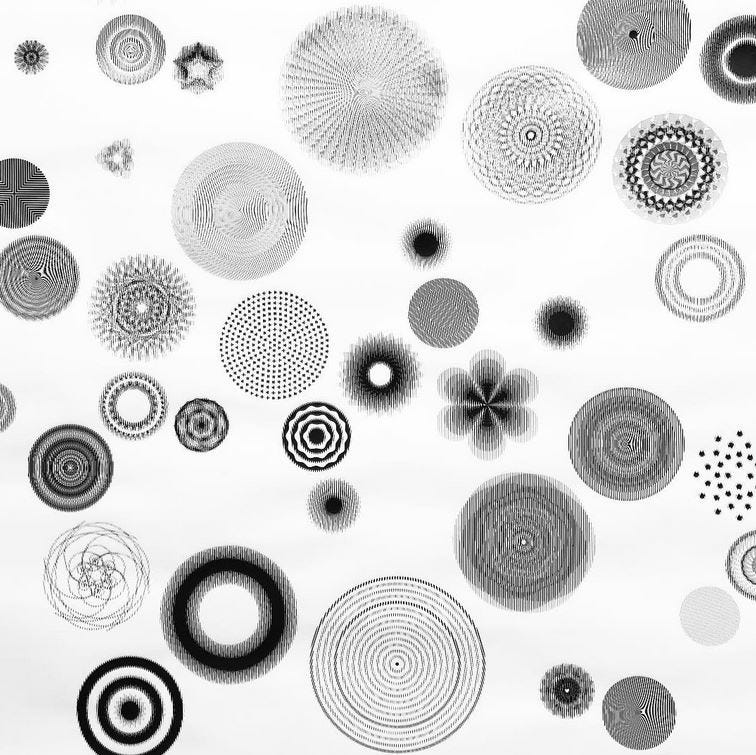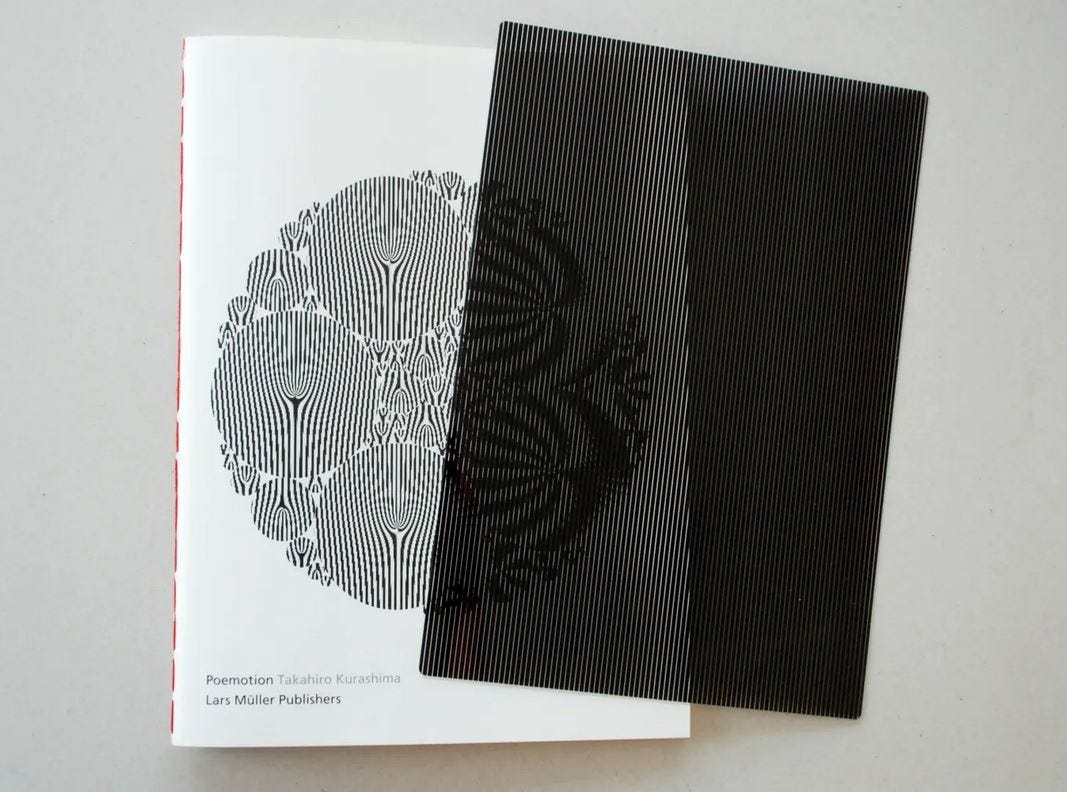EA: Can you tell me the story about how you developed your books?
TK: I have worked with many clients as a graphic designer before. In my graphic design work, where elements are simplified, organized, and structured, I found it interesting to combine simple forms to create new shapes. I have continued to create many forms. I was particularly fascinated by forms that were not symmetrical. There was movement in these forms. But I learned that it is also symmetry. So I came up with the idea of moving the shapes along with the movement within the symmetry.
Using a technique used in old movie toys. I do not know the official name of this technique. In the film “Film Before Film / Werner Nekes” it was called Omblo Cinema. (I was very much influenced by this movie). At the same time, I was attracted to the book “SeeSaw / Hans Knuchel / Lars Müller Publishers” and was also influenced by one of the pages in the book where you experience moiré. Then I created "Poemotion 1," a picture book with a striped film inside the book that enjoy both animation (planning) and moiré (coincidence) at the same time.
EA: I noticed your Poemotion books don't have a lot of words inside, which seemed a little bit mysterious in a good way, it made me wonder more about you and about the book itself. Did you prefer to keep it minimal like that?
TK: Yes. I wanted to create picture books that could be enjoyed by both adults and children, regardless of country or gender. But the title is important for me, because I believe that a form only exists when I give it a name, so I gave each form its own name. (with a little difficulty)
EA: Can you explain the plastic film that is inside the books? What exactly is it doing when it's moved across the page?
TK: By seeing the six images in sequence through the striped film (5 black: 1 transparent)…are recognized as moving images.
EA: Is there something about lines that our minds and eyes have issues processing?
TK: The beginning of Werner Nekes's film “Film Before Film”, there is a reference to the film as the product of the imperfection of the human eye. “Fundamental to the development of film was the recognition of the fact that the eye—the human eye—is sluggish.” I hope that my book will evoke a similar feeling and make people think about what it means to see.
EA: How do you create your designs?
TK: I typically sketch out my ideas, then use the computer to complete them. I need to take my time and create many designs because I cannot judge if they are good or bad until after they are completed.
EA: Do you know how a design will interact with the film before you make it?
TK: I will make some predictions, but I am looking for results that exceed my expectations.
EA: Do you have an opinion on the idea of perfection?
TK: This is a difficult question, but I am always concerned with figure-ground relationships, proportions, and regularity. And I myself try to eliminate my own individuality.
EA: On the subject of perfection, Antoine de Saint Exupéry said: "It seems that perfection is attained not when there is nothing more to add, but when there is nothing more to remove."
TK: I learned similar views from Mies van der Rohe and Dieter Rams. It is “Less is More” and “Less but Better."
EA: Do you think maybe this might relate to symmetry?
TK: Yes…I believe it is very relevant.
EA: Percy Shelley wrote, "Poetry enlarges the circumference of the imagination" - do you think your books are like poems?
TK: Yes. That is how I named the title. “Poemotion” is a coined word of poem, emotion, and motion.
EA: When I asked the question "Can you explain the plastic film that is inside the books." Is there anything special about the plastic? Is it just a regular striped film, or is it made in a special way? I'm still trying to understand if there is something in the piece of plastic that makes the effect. Or is it just the lines moving across the page that create the effect?
TK: There is nothing special about the plastic. It's just an acetate film printed by silkscreen in black. One of the six frames can be seen through the gap between the striped film.
EA: Also can you explain more about the word you mentioned "moiré" ? I tried to translate it from French but I can't get the translation, when I put the word into a translator nothing comes up. I'm interested how you found this word?
TK: Even in Japanese, the word moiré is commonly referred to as "moiré" without translation. A dictionary search reveals that moiré is an Arabic/Persian word meaning a garment made of angora sheep's wool. Originally, moiré was a pattern that appears when fabric or netting is layered.
EA: I just did some more research, I see it's a French word for a type of pattern. So your description of it as coincidence is interesting. Can you explain more about your thoughts on moiré as coincidence?
TK: I am very interested in the coincidence that occurs within a calculated form, and have chosen the moiré effect as a means of expressing this. I want everyone to be surprised beyond their imagination when my work is completed. I want to be surprised myself, which is why I continue to create. What you see is not everything, I want to express something like the boundary between the "visible" and the "invisible."
EA: And if I understand things correctly, are you saying, when you develop a design that surprises you, does it feel like a coincidence to you? Does it give you a feeling of novelty?
TK: Yes. It feels like a coincidence to me and it also gives me a novelty.
EA: How did you become involved with Art of Play? They're a magic shop in my city. I think you also collaborated on a project with them?
TK: So Art of Play is a shop in your city! I now understand why you knew me. The shop sells my books published by Lars Müller Publishers and "The Art of Curiosity" which I provided illustrations. I have never visited there but I would like to visit someday. In their latest magazine "Tangram #4” I was interviewed and provided new illustrations.
EA: I was wondering if I can have you react to some quotes. Let me know if they mean anything to you? "Not everything that can be counted counts, and not everything that counts can be counted." - Albert Einstein
TK: Beautiful quote. I am not convinced with solid logic, but I believe I have come to a similar understanding through visual perception.
EA: "All change is a miracle to contemplate; but it is a miracle which is taking place every instant." - Thoreau
TK: …When I think about change, the law of inertia always comes to mind. If no force is applied to a stationary object, it will remain stationary. If you do not apply force to an object that continues to move, it will continue to move. I believe that the moment of change from stillness to movement is the miracle and life.
EA: Do you believe there's more to the world around us than we usually see with our eyes?
TK: Of course, I think so. We basically only look forward.
EA: Do you remember your dreams?
TK: I remember it for a few hours after I wake up, but soon forget it.
EA: Do you ever imagine or see designs in your dreams?
TK: Yes, I do. I usually see it when I am in a hurry. I wake up in the morning and check it out, sometimes it is a good idea.
EA: Do you have an opinion on mandalas?
TK: I don't know much about it, but I am fascinated. The principles of form are there.
EA: Do you think it's possible that there are energies in the universe that we haven't understood or discovered yet?
TK: I don't know, but it seems natural that there are things we don't know.
EA: Is it possible for something to be in two places at once?
TK: Yes. Schrödinger's cat stories are interesting and exciting.
EA: Can you explain your new acrylic pieces? Do the kinetic sculptures work in the same way as your books do?
TK: I would like to show you the real thing too. It's hard to tell with pictures and videos. Unlike a book, it is linked to the viewer's own movement without touching the pattern.
EA: What does success mean to you?
TK: When I am able to create something better than yesterday.
EA: You've had many exhibitions, your most recent exhibition was Motion and Symmetries?
TK: My most recent exhibition was "Motion in Symmetries"...I would like to exhibit in a foreign country someday.






EA: Is it ok if we talk more about some things that we already covered? For example, the boundary between the visible and the invisible that you mentioned. I feel like that statement has so much depth. Is there meaning in things we can't see? Maybe it's a philosophical question.
TK: Of course, I believe that what the eye cannot see also has meaning...You are right, I am interested in boundaries. I believe there is drama in boundaries.
EA: Do you consider your art psychedelic?
TK: I don't intend it myself, sometimes people say that. I am honored because I also like psychedelic art.
EA: Ah, interesting...In the beginning were you surprised that people in other countries were interested in your work? It must be interesting to reach other people through your art. Was that something you expected?









